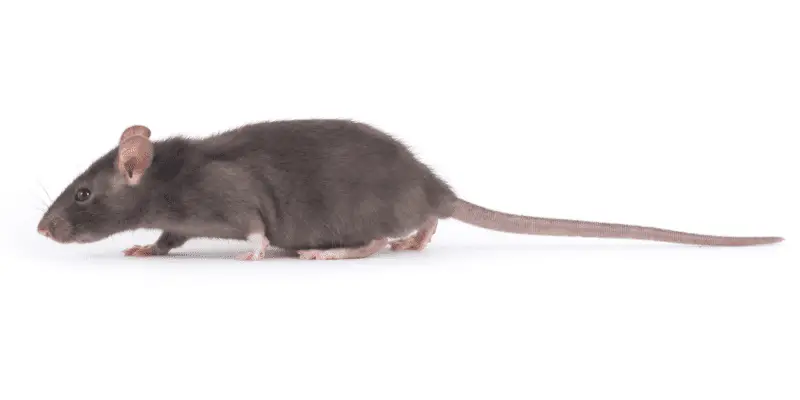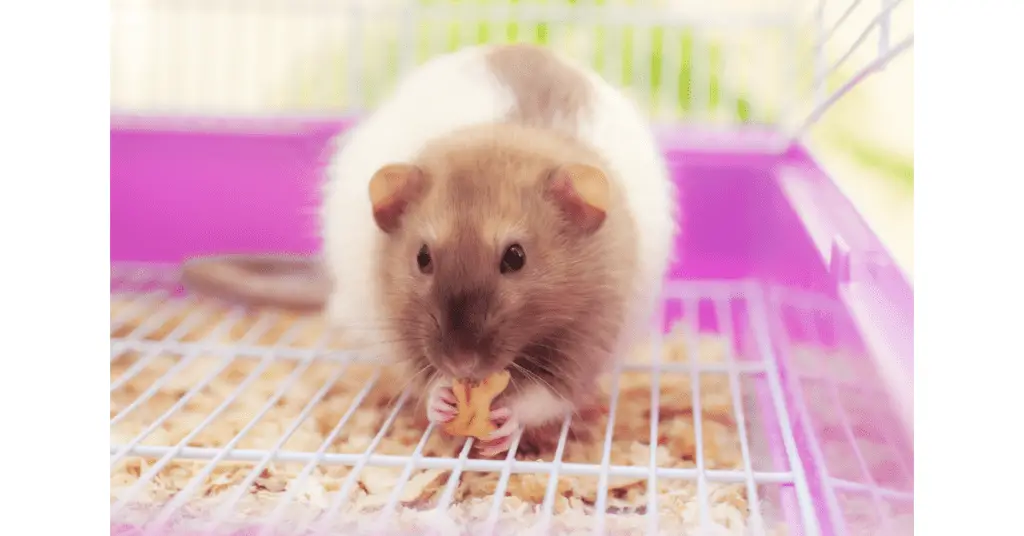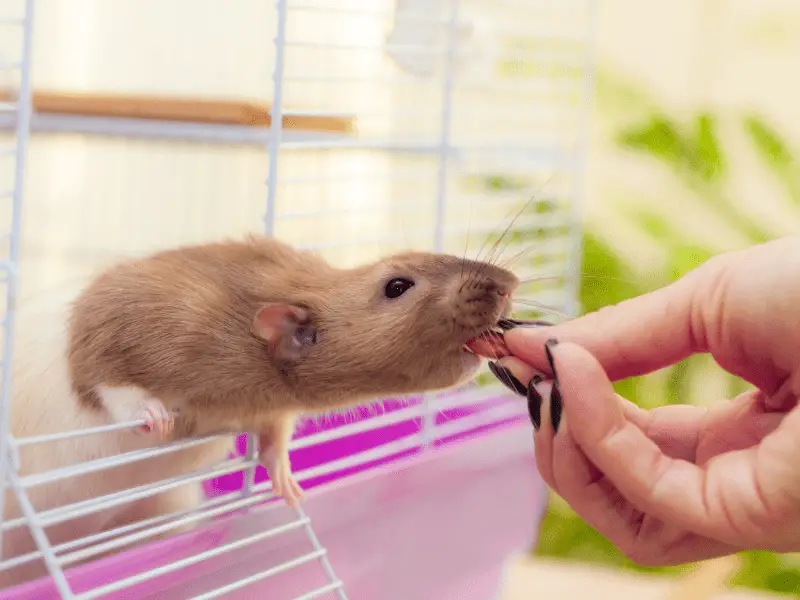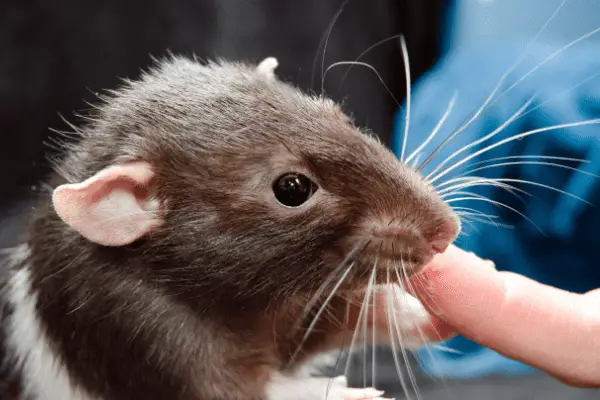This article contains affiliate links, and we may earn a commission at no cost to you if you choose to purchase through these links. I never recommend products that I do not trust or will not advise my veterinary clients and patients to use.
Rats tend to have a reduced appetite and resultant weight loss when they are ill. This article shares important considerations and tips from a vet to help your pet rat gain weight.
If you notice that your pet rat is losing weight, you should have them examined by your vet to find the cause for weight loss. To help your rat gain weight, you need to feed a high-quality complete rat diet and supplement with high calorie treats such as nuts, eggs, or high calorie veterinary and human supplements such as Ensure or Hills a/d.
How Do I Tell Whether My Rat Is Underweight?
By the time you can easily feel the spine and pelvis when stroking your rat, they have already lost more than 10% of their ideal body weight. This can be a scary thought. So, to avoid missing the small changes in your rat’s body weight, I advise rat owners to weigh their rats at least once every few weeks and at least once a week after your rat turns two years old or when they are sick. Just a regular old kitchen scale will do the job, but your bathroom scale will not, as you need a scale that will be able to weigh in smaller units.
To read more on how to weigh and do a physical check on your rat, have a look at my step-by-step guide on how to do a health check on your rat at home.
A healthy body weight for a particular rat can vary greatly depending on breed and sex. Visual body condition scoring is a much more reliable way to determine a healthy weight. Rat owners should monitor for changes in their rat’s weight by weighing them regularly. Male rats can weigh between 260 – 500g, and female rats can weigh between 230 to 350g.
Common reasons pet rats unintentionally lose weight include dental problems, poor diet, internal parasites, and chronic health conditions. To read more on the common reasons why rats lose weight, look at the section on the ten most common reasons rats lose weight in this article.
In a rat with a healthy body weight, you should not be able to feel their ribs when just placing your fingers on either side of their chest, but you should be able to feel the ribs when applying light pressure.

You should not be able to see any of the prominences of the vertebral bodies of the spine but should be able to feel the spine when applying light pressure. You should be able to feel the muscle running on either side and parallel to the spine, i.e., there should not be a groove on either side of the spine. The shoulder blades and pelvis should be well covered by muscle tissue.
If you can see individual spiny processes or see the outline of the pelvis or scapula, your rat is severely underweight.


What Should I Do When I My Rat Is Underweight?
If you notice weight loss in your rat, the underlying cause should always be investigated and addressed. Therefore, you need to take your rat to your vet as soon as you start noticing weight loss. Rats 18 months and older should be examined by your vet every six months as they become prone to illness from this age. Generally, the earlier a health problem is identified and addressed, the better the outcome and prognosis.
If you would like more detail on when you need to take your rat to the vet and when it should be safe to wait it out, have a look at this article.
In the meantime or in the absence of severe symptoms (you can check the abovementioned link to read on which symptoms need urgent veterinary attention), you can start feeding a higher calorie diet such as the food listed below, keep them as calm and happy as possible and consider deworming your rat.
I go into a lot more detail on the possible reasons for weight loss and what needs to be done for each in this article.
What Do Rats Need to Eat?
Rats, like us, are monogastric omnivores. Many of the things we enjoy eating, they want as well. In the wild, they will consume a large variety of plant materials such as roots, fruits, seeds, and grains and eat the occasional insect or bird egg.
Like us, rats need macronutrients, namely protein, fat, and carbohydrates. And then micronutrients are the vitamins and minerals they get from eating a varied diet of whole foods. When trying to get your rat to gain weight, the aim is to try and increase the number of calories they consume without increasing the volume of food they need to eat.
All three macronutrients are essential for weight gain; however, fat will give you the most bang for your buck as it contains more than double the amount of calories compared to carbohydrates and protein. Protein plays a vital role in rebuilding tissue cells, including muscle and organs. Carbohydrates are a great source of energy, and sources rich in carbohydrates are often rich in fiber, which is needed for gut health.
Rats are creatures of habit, and some rats may need extra encouragement and patience to try new things. You may find this especially true when trying to introduce some of the high-calorie foods to your rat if they have a reduced appetite. They are a bit like picky toddlers when it comes to eating. Try introducing new foods in small amounts in regular feeding places or at normal feeding times and mix in with the food they usually eat.

The base of your rat’s diet should always consist of a balanced formulated diet. Avoid rat mixes or rat muesli. These diets are very cleverly marketed to rat owners to be perceived as healthy and nutritious by humans but leave a lot of gaps in their nutrition.
Rats will often pick out their favorite bits and leave other bits behind, and some rats seem to have the propensity to eat the less nutritious components.
Rat cubes such as Oxbow Essentials Regal Rat Adult Food are an excellent choice as they are nutritionally complete and allow them to chew, which will aid in dental health and does not allow for selective feeding. For underweight rats, the Oxbow Essentials Mouse & Young Rat Food will be a good option as well as it is slightly higher in calories.
Diet Considerations For The Underweight Rat
In the diet for an underweight rat, you will have to supplement a complete diet with the food options listed below to bump up the number of calories they consume. In some cases where the rat has a reduced appetite, you will have to consider replacing a more significant portion of the diet with the calorie-dense options below until healthy body weight is achieved.
An adult rat needs at least 40 calories per day as a general rule. So if you are taking care of a sick rat, aim to give them at least this much each day.
Food Options To Help Your Rat Gain Weight
Here is a list of some of the high-calorie, nutritious foods that I have found most rats to enjoy. Offer your rat a variety of treats and see what they prefer. Remember only to offer small amounts at a time to prevent food from being stored and spoilt.
1. Nuts: Pecans, Brazil nuts, Walnuts etc.
Nuts are an excellent source of fat, vitamins, and minerals. This can be a perfect high-calorie treat if your rat enjoys something crunchy. Just beware that as their weight starts to normalize, you may have to cut back on this high-calorie tasty treat.

A few of my favorite nuts for rats are pecans, brazil nuts, walnuts, and almonds. Of course, peanuts are not off-limits, but these do carry a higher risk for mold that can be toxic to the liver, and offering globs of peanut butter can be a choking hazard, especially for older or frail rats.
If you want to give peanut butter, spread a thin layer on another snack food, like a slice of banana. As far as peanut butter containing xylitol, I would rather stay away as research is still lacking.
2. Liquid Human Nutritional Supplement like Ensure or Pediasure
Ensure Plus or Pediasure Grow & Gain are excellent nutritional supplements to keep in your first aid kit when your rat cannot eat by themselves. These are high-calorie and tasty liquid formulations that can easily be syringe-fed. Opt for strawberry or vanilla flavors as most rats prefer these flavors instead of chocolate or citrus flavors.

3. High Calorie Dog/Cat Recovery Food
Rats have very similar nutritional requirements to dogs and cats (the exception is that cats need a higher protein and lower carbohydrate diet compared to rats and dogs and rats). This means that high-calorie recovery nutrition is easily accessible at most pet stores.
I recommend either Hills a/d or Royal Canin Recovery. These are both a mousse-type consistency making it easy to mix with water to make it a more liquid consistency for syringe feeding. Don’t get it on your fingers, or your fingers will smell like dog food for the remainder of that day – not so appetizing when you try to eat your sandwich for lunch!
4. Meal Worms
This is not necessarily a very high-calorie option due to the high water content (around 64%), but mealworms are an excellent source of high-quality protein and a decent source of fat. Some rats will go crazy for mealworms- especially the fresh ones.
If you can only find dried mealworms, soak them in a small amount of water to help increase the water intake and prevent dehydration in the case of a rat with a poor appetite.
5. Nutrical
Tomlyn Nutri-Cal for puppies is a high-calorie malt-flavored nutritional supplement. It’s a tasty, sticky paste rich in vitamins, minerals, and essential amino acids. You can offer a small amount on the tip of your finger or rub a small drop onto their mouth.

6. Full Cream Yogurt or Cheese
Most rats can tolerate a small amount of dairy. Start by giving a small amount and check your rat’s poop. If they have runny stool 8-18 hours after having dairy, you may need to skip the dairy, nut if they can tolerate small amounts of cheese or yogurt, this can be an excellent source of fat and protein while being rich in a multitude of micronutrients as well. To re-iterate: give small portions only as most rats have a limited ability to digest lactose.
7. Puppy Food
As mentioned previously, there are a lot of similarities between rat and dog nutritional requirements. If you choose to try this route, it should be to supplement a rat diet such as the Oxbow Essential Rat food. I included this one as dog food is often much easier to source, and some rats do enjoy dog food a lot.
If you have an underweight rat, you should look to buy either small or medium breed puppy (for example, Hills Puppy Small Bite) food or active/performance adult dog food (for instance, Purina Pro Plan Sport). Both of these are higher in calories. Always buy small or medium breed dog food as large and giant breed dog food has fewer calories per gram.
8. Banannas
Most rats love the taste of bananas. Bananas are a good source of carbohydrates some fiber and are rich in essential micronutrients. Feed fresh bananas if your rat may be dehydrated (not eating well, sick, or has diarrhea), but the dried banana chips can be a great crunchy snack that will make less of a mess.
9. Eggs
Eggs are a powerhouse for protein, fat, vitamins, and minerals. One tablespoon of scrambled eggs is a highly nutritious snack; forego the salt and spices.
If you have more than one rat, you can offer them a hard-boiled egg and then crack the shell in one spot. This is a wonderful way to keep them entertained for a while as they try and figure out how to get into the egg.
One whole hard-boiled egg may be a little too much for one rat, and they will likely hide pieces of it that will eventually go bad.
10. Pasta
Pasta is a good source of easily digestible carbohydrates. Most rats will enjoy a piece of pasta now and then. Try to offer a cooked piece of macaroni. If your rat can tolerate a small amount of cheese, you can even stuff the macaroni with a few pieces of grated cheese.
A Few Things To Keep In Mind When Feeding for Weight Gain
When offering your rat these high-calorie foods, there are a few things to keep in mind:
Firstly, rats will sometimes hide food when offered more than they can consume straight away. This will lead to rotten food and a smelly rat enclosure. Check that your rat is not hiding food away to avoid the risk of them eating spoilt food. An upset tummy will not do your rat’s weight-gaining efforts any favors.
Secondly, you need to watch the scale to ensure that it is not tipping towards the wrong side. Obesity in rats is strongly linked with a shorter life span and a higher incidence of tumor growth (Mukherjee et al., 2021).
For more information on overeating in rats and how to prevent it, look at this article.
Conclusion
- If you suspect that your rat is starting to loose weight, you should seek veterinary attention as soon as possible as weight loss is often only noticed after considerable amount of body weight is already lost.
- You should weigh your rat often and take them for regular vet checks in order to identify and address potential problems early on.
- Feeding a high quality diet, and supplementing with high calorie snacks is the the most affective way to help your pet rat gain weight.
References
- Banks, R., 2013. Exotic small mammal care and husbandry. Hoboken: John Wiley, pp.81 – 92. https://onlinelibrary.wiley.com/doi/book/10.1002/9781119265405
- Harris, R., Mitchell, T., Simpson, J., Redmann, S., Youngblood, B. and Ryan, D., 2002. Weight loss in rats exposed to repeated acute restraint stress is independent of energy or leptin status. American Journal of Physiology-Regulatory, Integrative and Comparative Physiology, 282(1), pp.R77-R88. https://journals.physiology.org/doi/full/10.1152/ajpregu.2002.282.1.R77
- Harris, R., Zhou, J., Youngblood, B., Rybkin, I., Smagin, G. and Ryan, D., 1998. Effect of repeated stress on body weight and body composition of rats fed low- and high-fat diets. American Journal of Physiology-Regulatory, Integrative and Comparative Physiology, 275(6), pp.R1928-R1938. https://www.researchgate.net/publication/13443615_Effect_of_repeated_stress_on_body_weight_and_body_composition_of_rats_fed_low-_and_high-fat_diets
- Ho, V., Leung, K., Hsu, A., Luk, B., Lai, J., Shen, S., Minchinton, A., Waterhouse, D., Bally, M., Lin, W., Nelson, B., Sly, L. and Krystal, G., 2011. A Low Carbohydrate, High Protein Diet Slows Tumor Growth and Prevents Cancer Initiation. Cancer Research, 71(13), pp.4484-4493. https://cancerres.aacrjournals.org/content/71/13/4484.short
- Meredith, A. and Redrobe, S., 2002. BSAVA manual of exotic pets. 4th ed. Quedgeley: British Small Animal Veterinary Association, pp.13 – 25. https://www.researchgate.net/publication/240493099_The_BSAVA_Manual_of_Exotic_Pets_4th_edn
- Mukherjee, P., Sotnikov, A., Mangian, H., Zhou, J., Visek, W. and Clinton, S., 2021. Energy Intake and Prostate Tumor Growth, Angiogenesis, and Vascular Endothelial Growth Factor Expression. https://academic.oup.com/jnci/article/91/6/512/2549359?login=true
- O’Malley, B., 2005. Clinical anatomy and physiology of exotic species. Elsevier, pp.209 – 225. https://www.sciencedirect.com/book/9780702027826/clinical-anatomy-and-physiology-of-exotic-species
- Iske, C., 2019. What Should I feed My Pet Rat?. [online] Oxbow Animal Health. Available at: <https://www.oxbowanimalhealth.com/blog/what-should-i-feed-my-pet-rat/> [Accessed 16 February 2022].
- Truhaut, R., Coquet, B., Fouillet, X., Galland, L., Guyot, D., Rouaud, J. and Long, D., 1977. Sub-acute toxicity of xylitol in rats; absence of hepatotoxicity. Toxicology, 8(1), pp.79-85. https://pubmed.ncbi.nlm.nih.gov/929620/#:~:text=Some%20workers%20have%20suggested%20that,5%20and%2010%20g%2Fkg.

